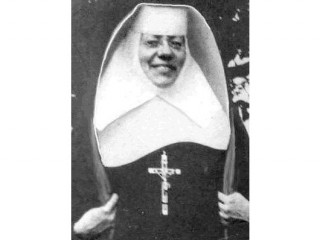
Katherine Drexel biography
Date of birth : 1858-11-26
Date of death : 1955-03-03
Birthplace : Philadelphia, Pennsylvania, U.S.
Nationality : American
Category : Famous Figures
Last modified : 2011-09-02
Credited as : Philantropist, nun,
Dedicating her life and her fortune to philanthropy, Katherine Drexel founded a Catholic order of sisters, the Sisters of the Blessed Sacrament, to work for Native Americans and African Americans.
Katherine Drexel was born in Philadelphia on November 26, 1858, the second daughter of Francis Drexel, a highly prosperous banker, and Hannah Langstroth, a Quaker. Hannah died five weeks later; her father married Emma Bouvier in 1860. They were devout Catholics, and both gave a great deal of their time and money to philanthropic activities. The children were educated privately and were encouraged to conduct a Sunday school for children of the employees at their family's summer home. The family travelled extensively in Europe and took a 6,000 mile trip through the American West in the private railroad car lent her father by James J. Hill, head of the Great Northern Railroad.
Drexel's full social and philanthropic life was jarred by the protracted illness, and then death in 1883, of her stepmother, to whom she was very devoted; two years later, her father died. She thought seriously of entering a convent where she could be totally absorbed in contemplation and prayer, but was persuaded by her religious counsellor not to make a hasty decision. Meanwhile, the Drexel young women were begged by a stream of churchmen to use their great wealth to help, as their parents had, in meeting the many crying needs of the Church—especially for missions in the West and the South. In 1889 Drexel began a novitiate with the Sisters of Mercy in Pittsburgh, with the understanding that in two years she would found her own order, the Sisters of the Blessed Sacrament, committed to the service of Native and African Americans; she would, she vowed, "be the mother and servant of these races."
Having taken a vow of poverty, she lived the rest of her life with extreme frugality. At the same time, her income from her father's trust (which increased substantially when her older sister died in childbirth) amounted to more than a $1,000 a day; she probably was, as the newspapers regularly declared, "the richest nun in the world." Receiving innumerable requests for aid, she concentrated her gifts on works which she could inspect and where—if possible— her Sisters could serve.
In the late 19th century Americans, especially in the East, were increasingly distressed by the abuse or neglect of the American Indians. The Catholic Church, hampered by poverty and the importunate needs of Catholic immigrants in the eastern cities, had been able to do less than many religious groups; and, the Church felt, with considerable reason, that the federal government discriminated against Catholic efforts both to minister to professedly Catholic Native Americans and to proselytize among non-Christian Native Americans. In the same years, most African Americans lived in the South; the Church was weak there, and hardly needed the additional stigma that would likely attend efforts that might seem in any way to jeopardize white supremacy.
In her 60 years of service, Drexel, more than any other person, spearheaded the effort of the Church to respond more compassionately and more efficiently to the needs of Native and African Americans. She gave more than $12 million of her own money, and at her death 501 members of her order supported 49 houses in 21 states. She was in a very real sense a one-woman foundation. She reviewed personally every request, often indicating her decision with a note on the letter of inquiry. She travelled tirelessly. She gave strong priority to the creation of church buildings and schools. No believer in segregation, she recognized that in her time a segregated church or school was often the most that could be hoped for. A strong advocate of liberal education (she helped establish what came to be Xavier University in New Orleans—the first Catholic college for African Americsns), she readily acquiesced in the belief that for many African Americans "vocational" education was the most pressing need. She generally confined her response to pleas for aid to inspecting, buying land, erecting buildings, and— occasionally—paying salaries. She had neither the time nor the inclination to supervise. One result of her practice was that she almost completely avoided conflict with the priests and bishops in charge of the missions.
By the terms of her father's will, she enjoyed only the income from the trust he had established. She was urged, from time to time, to use that income to create an endowment that would sustain, after her death, the institutions she had helped create. She did not do so. Perhaps she wanted to continue to make the spending decisions herself. Probably she wanted the Catholic laity, if not the whole American people, eventually to assume the responsibility of maintaining the institutions she had help start. Certainly she wholeheartedly endorsed the traditional notion that religious institutions should ultimately put their reliance on God's grace.
She received many awards in her lifetime, including the first honorary degree given by The Catholic University to a woman. She suffered a heart attack in 1935, and though she partly recovered, she was obliged to give up her leadership of the order. She lived in retirement with the sisters until her death in 1955, in her 97th year. In 1964 the Church began the long process of determining whether Mother Katherine should be beatified.
















